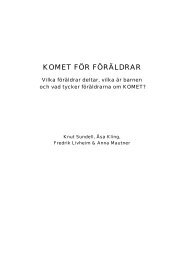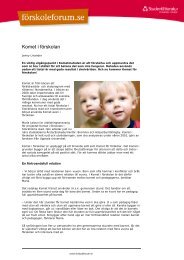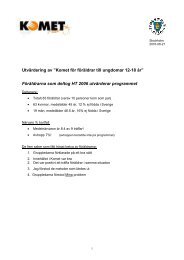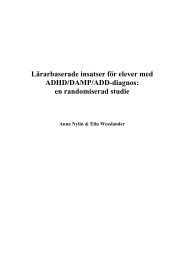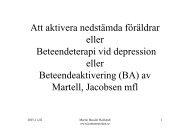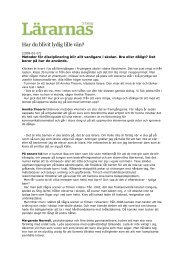EN GRUND FÖR ATT VÄXA - Kometprogrammet
EN GRUND FÖR ATT VÄXA - Kometprogrammet
EN GRUND FÖR ATT VÄXA - Kometprogrammet
Create successful ePaper yourself
Turn your PDF publications into a flip-book with our unique Google optimized e-Paper software.
Huizinga, D. & Jakob-Chien, C. (1998). The contemporaneous co-occurrence of serious andviolent juvenile offending and other problem behaviors. Ingår i R. Loeber & D. P. Farrington(red.), Serious & violent juvenile offenders. Risk factors and successful interventions.London: Sage.Hurry, J. & McGurk, H. (1997). An evaluation of a primary prevention programme for schools.Addiction Research, 5, 23-38.Hurry, J., Lloyd, C., & McGurk, H. (2000). Long-term effects of drug education in primaryschool. Addiction Research, 8, 183-202.Hvitfeldt, T., Andersson, B. & Hibell, B. (2002). Skolelevers drogvanor 2001 (rapport 67).Stockholm: Centralförbundet för alkohol- och narkotikaupplysning.Ialongo, N. S., Werthamer, L., Kellam, S. G., Hendricks Brown, C., Wang, S., & Lin, Y.(1999). Proximal impact of two first-grade preventive interventions on the early risk behaviorsfor later substance abuse, depression, and antisocial behavior. American Journalof Community Psychology, 27, 599-641.Jonsson, J. O., Helve, H. & Wichström, L. (2003). Youth research in Sweden 1995-2001. Anevaluation report. Stockholm: Forskningsrådet för arbetsliv och socialvetenskap.Karlberg, M. (2003). Motivera störande barn. En utvärdering av två metoder för lärare att arbetamed störande barn i klassrummet. Uppsala universitet: Institutionen för Lärarutbildning.Karlberg, M. & Sundell, K. (2004). Skolk - sund protest eller riskbeteende? (FoU-rapport2004:1). Stockholms socialtjänstförvaltning: FoU-enheten.Kellam, S. G., Rebok, G. W., Ialongo, N., & Mayer, L. S. (1994). The course and malleabilityof aggressive behavior from early first grade into middle school: Results of a developmentalepidemiology-based preventive trial. Journal of child psychology and psychiatryand allied disciplines, 35, 259-281.Lagerberg, D. & Sundelin, C. (2000). Risk och prognos i socialt arbete med barn. Forskningsmetoderoch resultat. Stockholm: Gothia/CUS.Leifman, H. (2002). Konsumtionsvanor och alkoholproblem. Ingår i S. Andreasson (red.)(2002). Den svenska supen i det nya Europa. Nya villkor för alkoholprevention. Stockholm:Svenska FolkhälsoinstitutetLindsey, D., Martin, S. & Doh, J. (2002). The failure of intensive casework services to reducefoster care placemants: An examination of Family preservation studies. Children andYouth Services Review, 24, 743-775.Lindstrom, P. & Svensson, R. (1998). Attitudes towards drugs among school youths. Anevaluation of the Swedish DARE programme. Nordic Stud. Alcohol Drugs [EnglishSuppl], 15, 7-23.Lipsey, M. W. (1992). The effect of treatment on juvenile delinquents: Results from metaanalysis.Ingår i F. Loesel, D. Bender, & T. Bliesener (Eds.). Psychology and law: Internationalperspectives (pp. 131-143). Berlin; NY: Walter de Gruyter.Lipsey, M. W., Chapman, G. L. & Landenberger, N. A. (2001). Cognitive-behavioral programsfor offenders. The Annals of the American Academy of Political and Social Science, 578,144-157.Lipsey, M. W. & Derzon, J. H. (1998a). Predictors of violent or serious delinquency in adolescenceand early adulthood: A synthesis of longitudinal research. Ingår i R. Loeber & D.P.Farrington (Eds.), Serious and Violent Juvenile Offenders: Risk Factors and SuccessfulInterventions. Thousand Oaks, CA: Sage.Lipsey, M. W. & Wilson, D. B. (1998b). Effective intervention for serious juvenile offenders: Asynthesis of research. Ingår i R. Loeber & D. P. Farrington (Eds.). Serious and ViolentJuvenile Offenders: Risk Factors and Successful Interventions. Thousand Oaks, CA:Sage.Lochman, J. E., Burch, P. R., Curry, J. F., & Lampron, L. B. (1984). Treatment and GeneralizationEffects of cognitive-behavioral an goal-setting interventions with aggressive boys.Journal of Clinical and Consulting Psychology, 52, 915-916.45



